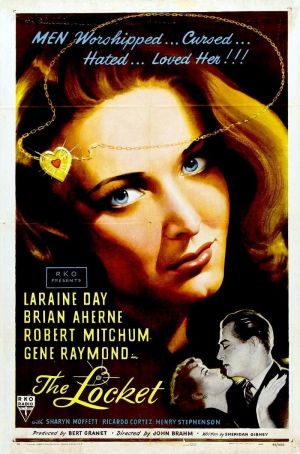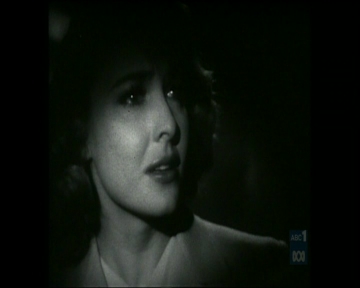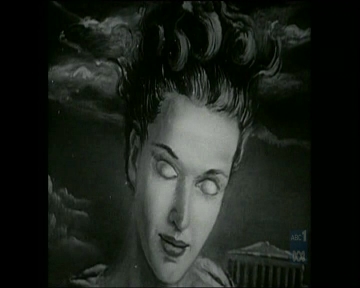A young woman who is a kleptomaniac and a pathological
liar wreaks havoc in the lives of three men
(1946 RKO. Direction by John Brahm 85 mins)
Cinematography by Nicholas Musuraca
Screenplay by Norma Barzman (uncredited) and Sheridan Gibney
Original Music by Roy Webb
Art Direction by Albert S. D’Agostino and Alfred Herman
Starring:
Laraine Day – Nancy Monks Blair Patton
Brian Aherne – Dr. Harry Blair
Robert Mitchum – Norman Clyde
Gene Raymond – John Willis
“Never has the device of the flashback been taken so far. Narratives are jumbled up, parentheses opened, exploits slot one inside the other like those Chinese toys sold in bazaars, and the figure of the heroine gradually comes into focus: beneath her somewhat obscure charm there lurks a dangerous and perverse mythomaniac”
– Borde & Chaumeton, A Panorama of American Film Noir 1941-1953 (1955)
“The Locket is a radically ambivalent film… [it’s] oscillation between condemnation and sympathy for its central protagonist, draws attention to the processes of narration and to the attempt of male narrators to control the ‘problem’ of femininity.”
– Andrew Spicer, Film Noir (2002)
The Locket is a bizarre melodrama that marks one the first films noir to use Freudian concepts to explore criminal psychology. Though the film is studio bound, the film-makers have used this constraint to advantage. Under the assured direction of John Brahm [who also directed The Brasher Doubloon (1947), Hangover Square (1945), and The Lodger (1944)], cinematographer Musuruca, and art directors Albert S. D’Agostino and Alfred Herman, place the story firmly in a suffocatingly surreal mise-en-scene. The atmosphere is decidedly gloomy – even baroque – with many dramatic scenes so darkly lit that there is aura of grim foreboding that goes far beyond the immediate action.
Larain Day, a little known b-actress, is entirely convincing as Nancy, the woman who weaves an elaborate charade only a disturbed mind could navigate, handling the melodramatic climax with considerable style.
The first thing that takes your breath away is what Borde & Chaumeton describe as a “technical shot in the dark”: the audacious use of flashback. There are two male narrators and finally Nancy herself, who each in turn construct a flashback within a flashback within a flashback. The final flashback takes Nany back to her childhood where her widowed mother works as a servant in the mansion of a haughty rich woman. The scenario in this flashback intelligently establishes the root cause of Nancy’s psychosis, while her treatment as a child of ‘the help’ initiates in the viewer sympathy for the character as a child, and an ambivalent empathy for the troubled woman she becomes.
A music box and its tune is a strong motif in the film, and in the climactic ending, this musical motif triggers a psychotic episode that is both cathartic and catastrophic. These scenes depicting Nancy’s disintegrating mental and physical state are inventively portrayed by innovative camera-work and by Roy Webb’s musical acumen.
The theme of entrapment is multi-layered. While Nancy is a prisoner of her compulsion and childhood trauma, each of the men who love her is equally attracted and repelled by the enigma that lies beneath her longed for persona. One of the men, an artist played by Robert Mitchum, expresses this exasperation in a portrait of Nancy in which her eyes are incomplete.
A must-see noir.




I will have more to say about this intriguing film later today during my afternoon prep. Again Mr. D’Ambra has intrigued us with a review of a film that has not yet been seen, although the esteemed Mssrs. Braham and Musuraca need no introduction.
LikeLike
“this musical motif triggers a psychotic episode that is both cathartic and catastrophic.”
Fascinating and exciting observations like this are what consistantly make this website and its proprietor as the best place for film noir enthusiasts to spend their precious time. Mr. D’Ambra has again fashioned an essay of descriptive insights, and has footnoted his piece with a cogent flashback quote–“a technical shot in the dark”– from Borde and Chaumenton and another statement from the ever-reliable Andrew Spicer.
The story of a person who is both a “kleptomaniac” and a “pathological liar” is interesting in an of itself, without the added fascination of “Freudian concepts to explore criminal psychology” and yet another noir treatment of “entrapment” which has been featured several times this month in other reviews here at filmsnoir.net. I am intrigued by the promise of “baroque atmosphere” and the glorious complicity of that incomparable RKO team, the esteemed Nicholas Musuraca, composer Roy webb and crack art director Albert D’Agostino. Of course, John Braham (as noted by Tony) directed both “The Lodger” and “Hangover Square” two films I HAVE seen, and value most highly, especially the former.
And who could not be just a little excited over the prospects of a film that is inhibited by the likes of Brian Aherne, Robert Mitchum and Gene Raymond.
Magnificent and authoritative treatment of a relatively hard-to-find but apparently essential noir.
LikeLike
Thanks Sam as always for your effusive support.
LikeLike
Hi! Tony,
I guess I have to seek this title out again, after reading your review.
Because I must admit after viewing this film for the first time, I just watched it without any thought, but after reading your review I plan to dissect it upon viewing it again.
Tks, 😉
Btw,_’_ _ _ _ _ I can’t wait! for Publishing Clearing House to knock on your door!…Mr._’_ _ _ _ _, you are entitled to a “Zillion” dollars only if darkcitydame, say your last name!…Will she say his last name again?…hmmm…Stay Tune!
LikeLike
I do enjoy this film a great deal, Tony, and your write-up here is quite the provocatively intelligent piece on it. I love your points about the film’s “suffocatingly surreal mise-en-scene,” and the gloomy, baroque atmosphere in which the plot unfolds. Simply superlative.
LikeLike
Ok Dcd, you have a bet!
LikeLike
Thanks Alexander! Yes, if given the attention it deserves, The Locket is a film that is richly rewarding.
LikeLike
This is a fascinating and haunting film.
I think the psychology is very plausible and you feel nothing but sympathy for the traumatised woman
LikeLike
Exactly what was the name of the tune the music box played? It sounds like the same tune Rhoda played on the piano in the movie The Bad Seed.
LikeLike
Mark as far as I know the music box tune is based on a French folk song.
LikeLike